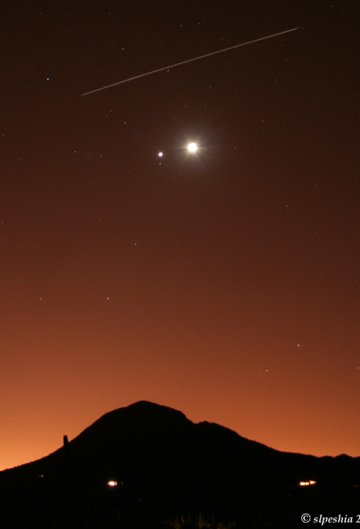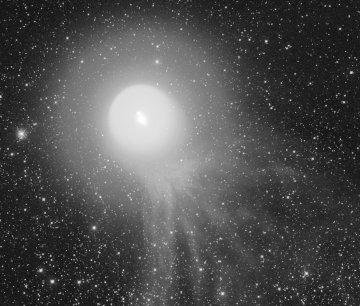 Where's Saturn? Is that a UFO--or the ISS? What's the name of that star? Get the answers from mySKY--a fun new astronomy helper from Meade. Where's Saturn? Is that a UFO--or the ISS? What's the name of that star? Get the answers from mySKY--a fun new astronomy helper from Meade. VENUS AT NOON: Venus is bright enough to see in broad daylight; the trick is finding it in the wide blue sky. Today it's easy because Venus is located beside the crescent Moon. Find the Moon and scan the sky nearby for a silver pinprick of light--Venus at noon! MONDAY MORNING SKY SHOW: "This was worth waking up for," says Scott Peshia of Tucson, Arizona, who rolled out of bed at 4:30 am to see the International Space Station and space shuttle Discovery glide past Venus and the Moon before sunrise: 
After the flyby, a couple of Taurid meteors appeared. "The first was extremely fast and long and the second was a short, very bright burst which lit up the landscape around me." It was a fantastic sky show. The show's not over. For the next 24 hours, Discovery and the International Space Station will orbit Earth together, appearing in the night sky as side-by-side points of light. Check Heavens-Above for flyby times or sign up for Spaceweather PHONE to receive email and phone alerts when the ISS is about to fly over your hometown. more images: from Becky Ramotowski of Tijeras, New Mexico; from Mike Lynch of Frankfort, Kentucky. COMET TAIL: Long exposures are starting to reveal the ragged tail of Comet 17P/Holmes. It took Michael Jäger eighteen minutes to record this view through his 8-inch telescope in Stixendorf, Austria: 
The tail, which color photos show to be blue, looks like the aftermath of a terrific explosion. Indeed, Comet 17P/Holmes did explode on Oct. 23rd, brightening a million-fold to naked eye visibility. But the appearance of the tail is probably not a consequence of that blast. Why not? It's our point of view. Usually we see comet tails from the side and they make a long graceful arc through space. The tail of Comet Holmes, however, points almost directly away from Earth. Instead of seeing it from the side, we're seeing it end-on, resulting in its peculiar frayed appearance. Everything about Comet Holmes seems a little peculiar--including the fact that anyone can see it. It's an "urban comet" visible to the naked eye among city lights as well as from the darker countryside. After sunset, look north for an expanding fuzzball in the constellation Perseus: sky map. The comet is about as bright as the stars of the Big Dipper and makes a fine target for both binoculars and backyard telescopes. Comet 17P/Holmes Photo Gallery
[Interactive World Map of Comet Photos]
[sky map] [ephemeris] [3D orbit] [Night Sky Cameras]
| 
